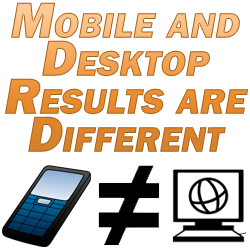If you’re doing a ranking check for a page on your website, you may notice that your mobile and desktop results are different. You might be wondering why they’re different, sometimes wildly so. You can be ranking number 1 for a page on desktop but mobile you’re not even making the first page. Let’s talk about the main reason to account for this disparity.
Why Mobile and Desktop Results are Different
The main reason your mobile and desktop results are different is in how your website is optimized for the two platforms (mobile and desktop).
The core web vitals May 2021 update emphasized the importance of fast loading web pages.

Google is obsessed with speed and for good reason. They don’t want to serve up a bunch of slow loading, resource hogging websites in their SERPs. This is especially true regarding their mobile SERPs because mobile connections are generally slower than desktop connections.
With that in mind, Google will be more forgiving of pages featuring heavy resources in their desktop SERPs. This is reflected in the two unique scores a web page can receive at https://developers.google.com/speed/pagespeed/insights/; one for desktop and one for mobile.
The desktop score will typically be higher than mobile in part because it accounts for faster connection speeds. So some of the things which are a problem for your web page on mobile won’t be on desktop.
As such, Google is more likely to give that page a better ranking on desktop than on mobile, sometimes significantly so.
How to Rank Well on Both Mobile and Desktop
Obviously the goal is to rank well on both mobile and desktop devices. You can do this a few different ways:
Optimizing Your Content
You can optimize your content to make it load more efficiently/faster in a number of ways, including:
- Compressing Images – There are plenty of free plugins to convert your images to smaller file sizes without sacrificing quality.
- Caching Your Website – Using a caching plugin ensures that static content doesn’t need to load every time someone returns to your site.
- Using a Content Delivery Nework – A CDN creates cached versions of your site on servers around the globe. This allows a user to connect to your website on a server which is physically closer to them, reducing load time.
- Minifying Code – Removing white space in your page’s code makes it load more efficiently. There are plugins which will do this for you.
- Defering Content – You can defer non-essential scripts so that they load after the rest of the page has loaded. Like most of the other techniques mentioned here, a caching plugin will do this for you.
- Removing Bloated Content – Take a genuine look at the content on a slow loading page and ask yourself if you need it all. There’s no better way to speed up a page than outright removing bloated content from it.
Using a Responsive Design
It’s essential today to use a responsive design on your website. A responsive design dynamically allows the user’s device who is accessing your site to dictate the sizing of it when it loads.
This is in contrast to using a static design which doesn’t take the device accessing the site into account. In this case, your website will load on a phone as if it was a huge desktop monitor. As you can imagine, this doesn’t work well.
Most WordPress themes today are responsive. Some even allow you to set a dedicated and unique menu for mobile devices.
Creating a Unique Mobile Site
Taking this idea one step further, you can also create a designated mobile version of your website which automatically loads for mobile users. There are plenty of plugins and services which will do this for you.
It’s a lot more work as you’d imagine, but you have the assurance of knowing your site will look good across all devices.
Ultimately, if you find that your mobile and desktop results are different, the key is to optimize your site for all devices. Note that there will always be some kind of disparity between the two sets of ranking.
But these tips will ensure that you have a good chance of ranking well for both (assuming your content is good).

Pingback: Ubersuggest Individual Review - Angry SEOer